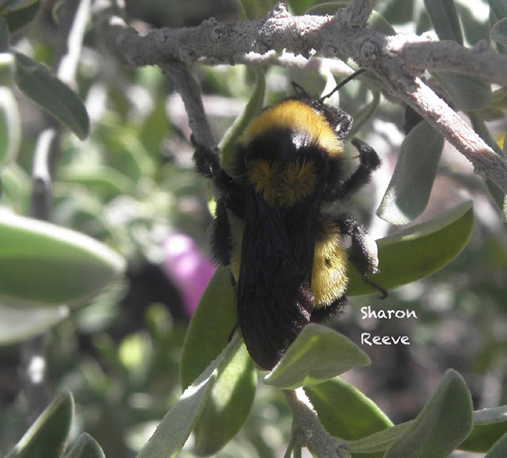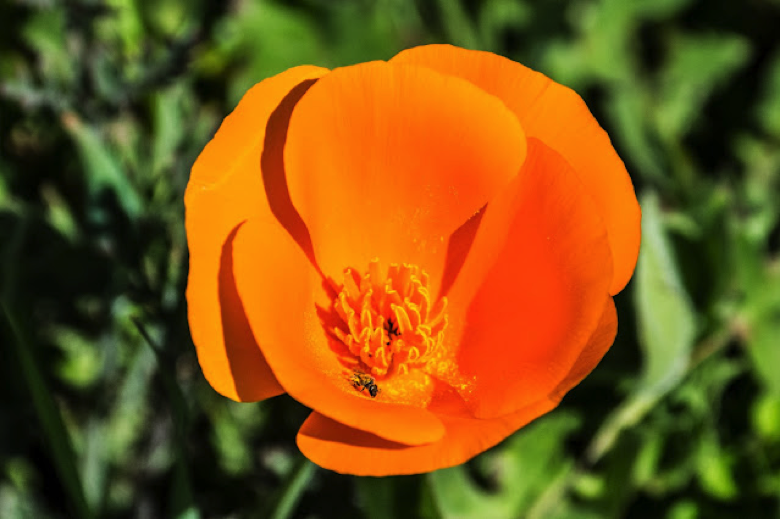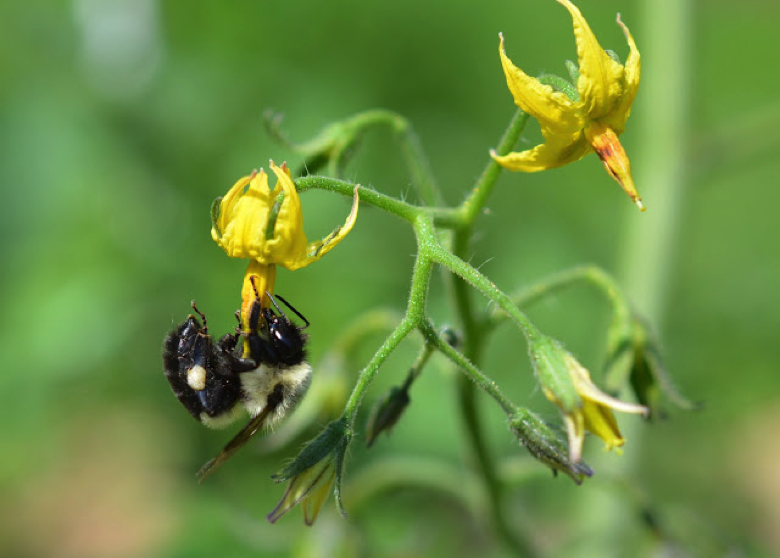Fascinating Native Bumblebees

Bombus sonorus- Summertime bumblebee in San Diego
By SHARON REEVE
While everyone is aware of, and recognizes, a common European honeybee, most people wouldn't be able to recognize a native bee. A good reason for this is because they come in a large variety of shapes and sizes, ranging from barely visible to large glossy black carpenter bees. It is very likely that a wide variety of native bees are already in your garden.
While carpenter bees fly past very visibly, most of the others zip past with little fanfare and a great deal of haste, as they have little time to waste. From the time they emerge from their cocoons. the females are devoted to one thing and one thing only, the building and provisioning of their nests. The males, on the other hand, have nothing to do but mate with as many females as possible, and to fight off other males trying to do the same. Anything that keeps this from happening reduces their chances of passing on their genes to the next generation. They are set on maximizing their reproduction.

Tiny Halictus bee on a California Poppy (Don 0wens)
A novel way native bees can speed things up is by "traplining". This is a remarkably clever foraging strategy that seems impossible in such a small creature as the bumblebee. Bees instinctually know to visit flowers for pollen, as nest food and for nectar, for their own energy needs. After finding the flowers, they must prioritize them according to the floral reward each individual patch of flowers provides. In just a few trips, bumblebees will sort out the most efficient route from their circuit of flowers back to the nest. Keep in mind this keeps changing as plants go in and out of bloom. Bees are traplining when they visit flower patches in a stable and repeatable sequence. It is remarkable to me that these tiny brains can accomplish such incredible feats.
To avoid wasting precious time, bumblebees also practice "floral constancy," spending more time on one species of flowers or species with similar floral characteristics or morphologies. By concentrating only on similar floral structures, the process and handling is as close to the same with each flower as possible. Using this method greatly speeds up how fast bees gather pollen. Different flower species vary wildly in their floral structure and where (or if) they have pollen. Using floral constancy as a foraging strategy is a powerful tool for the bees. It also allows other bees to concentrate on other floral forms so all the available flowers are used and pollinated most efficiently. Is that cool or what?

Buzz Pollination
Possibly the most fascinating time-saving trick used by bumblebees is called "buzz-pollination" or sonication. There are approximately 24,000 species of plants in different plant families that make it difficult for bees to get the pollen. You are familiar with at least a couple of the plants if you eat potatoes and tomatoes from the Solanaceae Family. The Solanaceae Family is unique in that the pollen is hidden in poricidal anthers. Normally, the pollen from plants is prominently displayed and easily accessible to pollinators on the distal end of anthers. Bumblebees have figured out a fast and efficient way to gather the hidden pollen in poricidal anthers. Imagine a tube with holes on the ends and pollen inside. This is roughly the shape and structure of a poricidal anther. Bumblebees land on the tubular anther, bite the end, and grasp it firmly with their clawed feet. To access the pollen, they disengage their flight muscles and vibrate them at a higher frequency. The force of the frequency forcibly expels the pollen and dumps it all over the bee. When you listen to this happening in the garden, the normal buzzing is interrupted by a high-pitched whine when the bee is sonicating. The magic frequency is about 270 Hz, “equivalent to a C-sharp above middle C on the piano. Sonication allows the bumblebee to pollinate much faster than normal.
This is a small snapshot into the wonderful world of native bumblebees, and it is by no means exhaustive. Please take care of the bees that visit the flowers in your garden. Consider planting native plants and minimizing pesticide use to increase the chances you will see more of these wondrous creatures in years to come.
Sharon Reeve has been a UCCE Master Gardener since 2012

